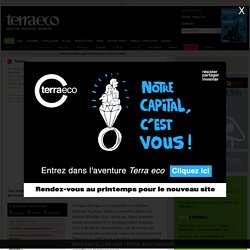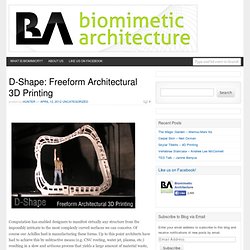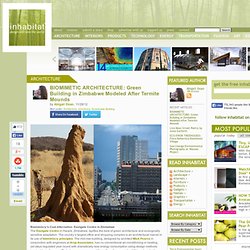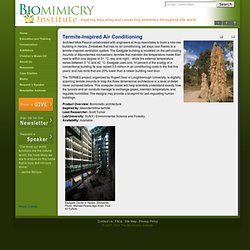

23 10 2015. Une hydrolienne à membrane copie les poissons Energie & Environnement, Energies renouvelables, Bio-mimétisme, Start-up, Hydrolien Par Philippe Passebon - publié le 23 octobre 2015 à 09:30 Une hydrolienne à membrane ondulante pour produire de l’électricité à partir des courants marins vient d’être mise au point par la start-up EEL Energy dans le bassin de l’Ifremer.

La technologie est basée sur le biomimétisme. Dans la nature marine, les systèmes à hélice sont en effet inexistants, les mouvements des animaux aquatiques étant presque tous basés sur des ondulations. Cinq inventions géniales inspirées par la nature. A chaque fois que vous rencontrez un problème, observez la nature.

Celle-ci a peut-être déjà eu les mêmes difficultés, et si c’est le cas, elle a sûrement trouvé une solution il y a quelques milliers d’années. Voilà la devise du biomimétisme, une démarche qui entend réconcilier progrès et respect de l’environnement. Théorisée en 1998 par la scientifique américaine Janine Benyus, elle séduit aujourd’hui des centaines de scientifiques et entrepreneurs. Leur credo : la nature reste le seul ingénieur capable de créer des multitudes de cycles de production sans consommer d’énergies fossiles, ni produire de déchets. Cet ingénieur original puise sa créativité dans les contraintes et s’adapte toujours à son environnement. Www.frac-centre.fr/upload/document/pedagogique/2013/FILE_5294cbe42d716_peda_13_thema_archilab_bd.pdf/peda_13_thema_archilab_bd.pdf.
FABI - Le Journal des Ingénieurs - n°111. Reperes pédagogiques en architecture. Les Echos Mai n°262 - Supplément Biomimétique. Les Echos Mai n° 262. Architecture biomimétique. MAIS QUELLE LANGUE PARLE LA NATURE. D-Shape: Freeform Architectural 3D Printing. Computation has enabled designers to manifest virtually any structure from the impossibly intricate to the most complexly curved surfaces we can conceive.

Of course our Achilles heel is manufacturing these forms. Up to this point architects have had to achieve this by subtractive means (e.g. CNC routing, water jet, plasma, etc.) resulting in a slow and arduous process that yields a large amount of material waste, well not anymore! The inventor, civil engineer, and Chairman of Monolite UK Ltd., Enrico Dini, has successfully created a freeform 3D printer for the building industry.
The machine is capable printing objects at 25DPI in an area that is 20 ft x 20 ft x 3 ft with a print tolerance between .20″ – .40″ dependent on steepness of curvature, and because of the reduced manpower and elimination of scaffolding prints at costs 30%-50% lower than conventional construction. Image by Monolite UK Ltd. & Faan Studio Image by Monolite UK Ltd. BIOMIMETIC ARCHITECTURE: Green Building in Zimbabwe Modeled After Termite Mounds. Biomimicry’s Cool Alternative: Eastgate Centre in Zimbabwe The Eastgate Centre in Harare, Zimbabwe, typifies the best of green architecture and ecologically sensitive adaptation.

The country’s largest office and shopping complex is an architectural marvel in its use of biomimicry principles. The mid-rise building, designed by architect Mick Pearce in conjunction with engineers at Arup Associates, has no conventional air-conditioning or heating, yet stays regulated year round with dramatically less energy consumption using design methods inspired by indigenous Zimbabwean masonry and the self-cooling mounds of African termites! Termites in Zimbabwe build gigantic mounds inside of which they farm a fungus that is their primary food source. The fungus must be kept at exactly 87 degrees F, while the temperatures outside range from 35 degrees F at night to 104 degrees F during the day. Biomimicry Institute - Termite-Inspired Air Conditioning.
Architect Mick Pearce collaborated with engineers at Arup Associates to build a mid-rise building in Harare, Zimbabwe that has no air-conditioning, yet stays cool thanks to a termite-inspired ventilation system.

The Eastgate building is modeled on the self-cooling mounds of Macrotermes michaelseni, termites that maintain the temperature inside their nest to within one degree of 31 °C, day and night, - while the external temperature varies between 3 °C and 42 °C. Eastgate uses only 10 percent of the energy of a conventional building its size, saved 3.5 million in air conditioning costs in the first five years, and has rents that are 20% lower than a newer building next door.
The TERMES project, organized by Rupert Soar of Loughborough University, is digitally scanning termite mounds to map the three dimensional architecture in a level of detail never achieved before. Eastgate Center in Harare, Zimbabwe. Photo: Michael Pearce/Aga Khan Trust for Culture. Bio-Computation (2012) from David Benjamin. GSAPP. Political and cultural conditions change: what if the walls and windows morphed in response?

Air and water quality fluctuate: what if a cloud of light above the river modulated its color as a public display of contamination? Demands for occupation of space shift across days, seasons, and years: what if traditionally mute and inert building materials appeared and disappeared accordingly? A dynamic world calls for responsiveness.
Responsiveness in architecture calls for new systems. New and untested systems call for full-scale prototyping. The Living Architecture Lab experiments with new systems and adaptive technologies through open source, collaborative, hands-on design. Each of the Lab's projects involves components for input, processing, and output. The Living. The Biotechnique of Phil Ross. Helena amalric design home. Biomimicry. TRIZ - Biomimétisme.